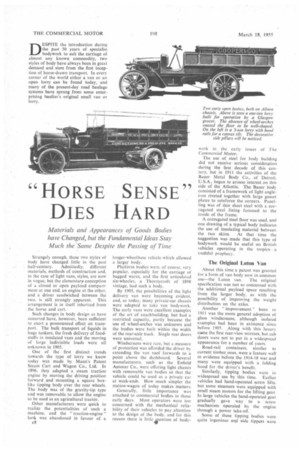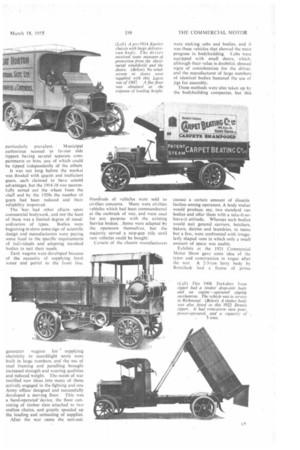"HORSE SENSE'' DIES HARD
Page 108

Page 109

Page 110

If you've noticed an error in this article please click here to report it so we can fix it.
Materials and Appearances of Goods Bodies have Changed, but the Fundamental Ideas Stay Much the Same Despite the Passing of Time
DESPITE the introduction during the past 50 years of specialist bodywork to suit the carriage of almost any known commodity, two styles of body have always been in great demand and stem from the first inception of horse-drawn transport. In every corner of the world either a van or an open lorry can be found today, and many of the present-day road haulage systems have sprung from some enterprising haulier's original small van or lorry.
Strangely enough, these two styles of body have changed little in the past half-century. Admittedly, different materials, methods of construction and, in the case of light vans, styles, are now in vogue, but the elementary, conception of a closed or open payload compartment at one end, an engine at the other, and a driver sandwiched between the two, is still strongly apparent. This arrangement is in itself inherited from the horse and cart..
Such changes in body design as have occurred have, however, been sufficient to exert a pronounced effect on transport. The bulk transport of liquids in huge tankers, the fresh delivery of foodstuffs in insulated vans and the moving of large indivisible loads were all unknown in 1905.
One of the first distinct trends towards the type of lorry we know today was made by Mann's Patent Steam Cart and Wagon Co., Ltd. In 1896. they adapted a steam traction engine by moving the driving position forward and mounting a square boxlike tipping body over the rear wheels. The body was of the gravity-tip type and was removable to allow the engine to be used as an agricultural tractor.
Other manufacturers were quick to realize the potentialities of such a machine, and the " traction-engine " look was abandoned in favour of a E8 longer-wheelbase vehicle -which allowed a larger body.
Platform bodies were, of course. very popular, especially for the carriage of bagged wares, and the first articulated six-wheeler, a Thornycroft of 1898 vintage, had such a body.
By 1905, the possibilities of the light delivery van were becoming evident, and as today, many private-car chassis were adapted to take van bodywork. The early vans were excellent examples of the art of coachbuilding, but had a restricted capacity, partly because the use of wheel-arches was unknown and the bodies were built within the width of the rear-axle track. Single rear doors were universal,
Windscreens were rare, hut a measure of protection was afforded the driver by extending the van roof forwards to a point above the dashboard. Several manufacturers, such as the Enfield Autocar Co.. were offering light chassis with removable van bodies so that the vehicle could be used as a private car at week-ends. How much simpler the station-wagon of today makes matters.
Generally. little importance was attached to commercial bodies in those early days. Most operators were too concerned with the mechanical reliability of their vehicles to pay attention to the design of the body. and for this reason there is littleention of body
work in the early issues of The Commercial Motor.
The use of steel for body building did not receive serious consideration during the first decade of this century, but in 1911 the activities of the Bauer Metal Body Co., of Detroit. U.S.A., began to arouse interest on this side of the Atlantic. The Bauer body consisted of a framework of light angleiron riveted together with large gusset plates to reinforce the corners. Panelling was of thin sheet steel with a corrugated steel -lining fastened to the inside of the frame.
A corrugated steel floor was used, and one drawing of a typical body indicates the use of insulating material between the two skins. At that time the suggestion was made that this type of bodywork would be useful on British vehicles operating in the tropics— a truthful prophecy.
The Original Luton Van
About this time a patent was granted for a form of van body now in common use—the Luton van. The original specification was not so concerned with the additional payload space resulting from the larger body, as with the possibility of improving the weight distribution on the axles.
Another " improvement " born in 1911 was the more general adoption of glass windscreens, although isolated examples had been in existence since before 1905. Along with this luxury came the first rear-view mirrors, but cab doors were not to put in a widespread appearance for a number of years.
Road-rail containers, similar to current timber ones, were a feature well in evidence before the 1914-18 war and many were equipped with a folding hood for the driver's benefit.
Similarly, tipping bodies were in widespread use by this time. Earlier vehicles had hand-operated screw lifts, but some steamers were equipped with small steam motors for the lifting gear. In large vehicles the band-operated gear gradually gave way to a screw mechanism operated by the engine through a power take-off.
Some of these tipping bodies were quite ingenious and side tippers were particularly prevalent. ' Municipal
authorities seemed to favour side tippers having several separate compartments or bins, any of which could be tipped independently of the others. It was riot long before the market was flooded with quaint and inefficient gears, each claimed to have untold advantages, but the 1914-18 war successfully sorted out the wheat from the chaff and by the 1920s the number of gears had been reduced and their reliability improved. • The had other effects upon commercial bodywork, and not the least of these was a limited degree of standardization of types. Bodies were beginning to show some sign of scientific design and manufacturers were paying some heed to the specific requirements of individuals and adapting standard bodies to suit their needs. Tank wagons were developed because of the necessity of supplying fresh water and petrol to the front Line.
generator wagons for • supplying electricity to searchlight units were built in large numbers, and the use of sled framing and panelling brought increased strength and wearing qualities and reduced weight. The needs of war instilled new ideas into many of those actively engaged in the fighting and one Army officer designed and successfully developed a moving floor. This was a hand-operated•device, the floor consisting of timber slats attached to two endless chains, and greatly speeded up the loading and unloading of supplies.
After the war came the sort-out.
lluneireds of vehicles were sold to civilian concerns. Many were civilian vehicles which had been commandeered at the outbreak of war, and were used for any purpose with the existing Service bodies. Some were adapted by the operators themselves, but the majority served a stop-gap role until new vehicles could be bought.
Certain of the chassis manufacturers
were making cabs and bodies, and it was these vehicles that showed the most progress in bodybuilding. Cabs were equipped with small doors, which. although their value is doubtful, showed signs of consideration for the driver. and the manufacturer of large numbers of identical bodies hastened the use of jigs for assembly, These methods were also taken up by the bodybuilding companies, but this caused a certain amount of dissatisfaction among operators. A body maker would produce, say, two standard van bodies and offer them with a take-it-orleave-it attitude. Whereas such bodies would suit general carriers, butchers, bakers, dairies and laundries, to name but a few, were confronted with irregularly shaped vans in which only a small amount of space was usable. Exhibits at the 1921 Commercial Motor Show gave some idea of the types and construction in vogue after the war. A 2-3-ton lorry body by Bonaliack had a frame of prime
English oak and sides constructed from deep lower panels and shallow upper panels. This was done to provide a clean surface for advertising matter. Sides were fixed, but the tailboard had forged hinges.
Van bodies were generally constructed with ash and oak frames and Honduras mahogany was a favourite medium for panelling. A novel idea which appeared that year was the " chafa-lorry made by the Willowbrook Motor Co. This was a conventional platform lorryto which was attached, by six bolts, a coach body. The body could be fitted by two men by sliding it into position and presumably the seats were fastened to the lorry floor.
A hydraulic tipper shown on the Albion stand had a modern-looking Ushaped steel body. It was a riveted assembly and the main framework was of heavy steel angle. A Bromilow and Edwards three-way tipper. with twin under-body ram. had a simple limber body with one-piece sides.
By 1922, the experts were beginning to realize the acute need for reducing body weight. At that time it was usual to estimate the weight of the body as a third of its load capacity. thus. a 3-tonner would have a body weighing a ton. Where metal panels were employed they were of lead-coated iron. but usually mahogany or three-ply birch was used.
A good omen for the future was seen in a van operated by J. LOns and Co., Ltd. This vehicle had a body built by the Dartford Engineering and Carriage Co.. Ltd. It was framed in duralumin and panelled in aluminium. The body was .unpainted. hut varnished, and although the weight is unknown, it must have been half that of an equivalent timber body.
During the next few years most body designs remained unchanged, although a revival of the old flamboyant " gipsy caravan" style of finish was seen for a while. A noticeable improvement in driver comfort was made towards the end of the 1920s by the adoption of cab doors with drop windows. The driver was now fully enclosed, after having been exposed to wind and rain from all directions for nearly 30 years.
Another feature which was gradually creeping into the limelight was the forward control driving position. Suddenly the realization dawned that by moving the cab over the engine a longer body could be fitted. One of the first concerns to use this arrangement was Lacre. who produced a , full forward-control 21-ton van in 1929.
These early examples were usually only half-cabs and the driver was extremely cramped, a fault which, with some designs, existed until only a few years ago.
In the 1930s "bodybuilding" became " body engineering and large. light and useful bodies came to the fore. Many of the old coachbuilding techniques were still used in the framework of composite vehicles, but sheet steel and alloy panelling were included in the specifications of most manufacturers and the general adoption of forward-control chassis allowed smooth lines to be given to van bodies.
The use of all-steel welded bodies in the car world encouraged body engineers to apply the same technique to commercial vehicles and many bodies now produced by chassis makers use this construction. The old art is still practised in certain quarters. but speed and low cost of production arc the order of the day and metal triumphs • over timber.
In the immediate future the increased use of plastics for body panels and welded aluminium framing is foreseeable, and it is possible that integral construction will become more widely employed for larger-capacity vehicles. The continued trend will be towards lighter and stronger bodies. J.F.M.








































































































































































































































































